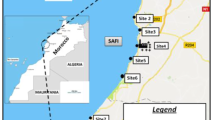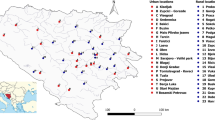Summary
An epiphytic lichen (Physcia alba sp.) grown over Roystonea regia tree was used as biomonitor of air quality in the Havana City west side. During the survey, 81 sampling sites were selected according to traffic and industry conditions. The concentration for 14 elements (Mg, Al, Ca, V, Cr, Mn, Fe, Co, Ni, Cu, Zn, Sr, Cd and Pb) was determined by flame atomic absorption spectrometry (FAAS) and anodic stripping voltammetry (ASV). Contents of Cu, Zn, Cd and Pb obtained by both techniques were compared. Several biological reference materials (RM's) were analyzed in order to assure the quality of analytical results. Some pollution sources were identified using principal component analysis. A total of 5 factors were achieved, of which 4 could be interpreted in terms of anthropogenic pollution sources. However, the expected correlation between traffic influence and lead concentration in lichen could not be demonstrated. The factor values patterns are presented.
Similar content being viewed by others
Author information
Authors and Affiliations
Rights and permissions
About this article
Cite this article
Montero Alvarez, A., Estévez Alvarez, J., Iglesias Brito, H. et al. Lichen based biomonitoring of air quality in Havana City west side. J Radioanal Nucl Chem 270, 63–67 (2006). https://doi.org/10.1007/s10967-006-0310-7
Issue Date:
DOI: https://doi.org/10.1007/s10967-006-0310-7




